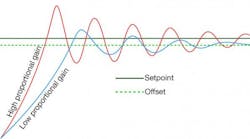Hey, don't look at me; I'm no expert in this field. But Robert Burton certainly was. He authored countless books and technical paper covering closed-loop control of electrohydraulic systems. He also contributed to Hydraulics & Pneumatics. And even though his works were published about 20 years ago, his insight into the behavior of loads, hydraulic flow and pressure, and electronic control are just as relevant today. The only difference is that today we use digital control control instead of analog — but, like gravity, the physics have not changed.
Below is a summary of one of his articles, and I'll be posting another article in a few days.
Most hydraulics practitioners can readily size valve-controlled hydraulic-cylinder power drives for position-control applications using hydraulic servos. However, determining the allowable loop gain to ensure a stable closed-loop output response seems to be a problem for many of them. Here’s a simple method for determining allowable loop gain that we have used many times during our 40 years involvement in hydraulic servo design.
Click here to read the article in its entirety.

